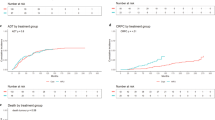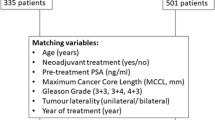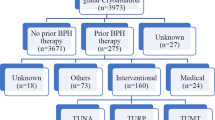Abstract
Background:
We aimed to evaluate oncological and functional outcomes of index lesion HIFU ablation with Focal-One®.
Materials and Methods:
We prospectively assessed treatment-naïve men with localized prostate cancer between 2017 and 2019. Inclusion criteria were stage cT ≤ 2, ≥5 years of life expectancy, grade group ≤3. Multiparametric magnetic resonance was performed before ablation. Patients with a prostate volume of ≥80 ml underwent debulking. Treatment failure was defined as a histologically confirmed tumor that required salvage treatment or androgen deprivation therapy.
Results:
One hundred and eighty nine patients were enrolled. Data are presented as median and Interquartile Range (IQR). Median age was 70(11) years. Median baseline PSA was 5.8(3) ng/ml. Fourteen (7.4%) patients had prostate debulking before ablation. 104 (55%) patients underwent targeted ablation, 45 (23.8%) extended targeted ablation, 31 (16.4%) hemiablation, and 9 (4.8%) extended hemiablation. Median targeted ablated volume was 14(9) ml. Ninety-three complications occurred in 63/189 (33.3%) patients within 90 days. There were 77/93 (82.8%) minor (Clavien grade 1–2) and 16/93 (17.2%) major complications (Clavien grade 3a). Thirty-nine patients suffered from genito-urinary infections (Clavien grade 2). Fifteen patients required transurethral resection of the prostate/urethrotomy for recurrent urinary retention (Clavien grade 3a). One patient developed a recto-urethral fistula (Clavien grade 3a) and two long-lasting urinary incontinence. Median PSA nadir was 2.2(2.9) ng/ml. At a median follow-up of 29(15) months, 21/177 (11.9%) patients were treatment failures, 26 on monitoring, and 26 had a further ablation. Multivariable logistic regression found that failure patients had higher PSA (7.8 vs 5.7 ng/ml,p0.001) and double PSA nadir (4.8 vs 2.0 ng/ml, p < 0.001). Higher PSA nadir correlated with a 74% higher probability of failure (OR 1.74 95% CI 1.40–2.16). Cancer in the anterior stroma increased the odds of failure of three folds (OR 3.36 95% CI 1.18–9.53). Two mixed effect models (one for IPSS and one for IEEF-15) were estimated and they showed that time reaches the statistical significance coefficient only for the IEEF-15, meaning that subsequent evaluations of the indicators were significantly lower at each time point.
Conclusions:
Index lesion HIFU ablation demonstrated satisfactory early oncological outcome but anteriorly located tumors had inadequate ablation. Urinary function was well preserved. Sexual function slightly decreased during follow-up.
This is a preview of subscription content, access via your institution
Access options
Subscribe to this journal
Receive 4 print issues and online access
$259.00 per year
only $64.75 per issue
Buy this article
- Purchase on Springer Link
- Instant access to full article PDF
Prices may be subject to local taxes which are calculated during checkout

Similar content being viewed by others
References
Mottet N, Bellmunt J, Bolla M, Briers E, Cumberbatch MG, De Santis M. et al. EAU-ESTRO-SIOG guidelines on prostate cancer. Part 1: screening, diagnosis, and local treatment with curative intent. Eur Urol. 2017;71:618–29.
Hamdy FC, Donovan JL, Lane JA, Mason M, Metcalfe C, Holding P, et al. 10-Year outcomes after monitoring, surgery, or radiotherapy for localized prostate cancer. N. Engl J Med. 2016;375:1415–24.
Donovan JL, Hamdy FC, Lane JA, Mason M, Metcalfe C, Walsh E, et al. Patient-reported outcomes after monitoring, surgery, or radiotherapy for prostate cancer. N. Engl J Med. 2016;375:1425–37.
Valerio M, Cerantola Y, Eggener SE, Lepor H, Catto J. New and established technology in focal ablation of the prostate: a systematic review. Eur Urol. 2017;71:17–34.
Ahmed HU. The index lesion and the origin of prostate cancer. N. Engl J Med. 2009;361:1704–6.
Liu W, Laitinen S, Khan S, Vihinen M, Kowalski J, Yu G. et al. Copy number analysis indicates monoclonal origin of lethal metastatic prostate cancer. Nat Med. 2009;15:559–65.
Guo CC, Wang Y, Xiao L, Troncoso P, Czerniak BA. The relationship of TMPRSS2-ERG gene fusion between primary and metastatic prostate cancers. Hum Pathol. 2012;43:644–9.
Connor MJ, Gorin MA, Ahmed HU, Nigam R. Focal therapy for localized prostate cancer in the era of routine multi-parametric MRI. Prostate Cancer Prostatic Dis. 2020;23:232–43.
Gelet A, Crouzet S, Rouviere O, Bratan F, Chapelon J-Y. Focal treatment of prostate cancer using Focal One device: pilot study results. J Ther Ultrasound. 2015;3:1–2.
Capogrosso P, Barret E. High-intensity focused ultrasound. In: Polascik TJ, editor. Imaging and focal therapy of early prostate cancer. Springer; 2017. p 309–323 (Springer, 2017).
Claros OR, Tourinho-Barbosa RR, Carneiro A, Collura-Merlier S, Macek P, Lanz C. et al. HIFU focal therapy for prostate cancer using intraoperatory contrast enhanced ultrasound. Arch Esp Urol. 2019;72:825–30.
von Hardenberg J, Westhoff N, Baumunk D, Hausmann D, Martini T, Marx A, et al. Prostate cancer treatment by the latest focal HIFU device with MRI/TRUS-fusion control biopsies: a prospective evaluation. Urol Oncol Semin Orig Investig. 2018;36:401.e1–401.e9.
Perez-Reggeti JI, Sanchez-Salas R, Sivaraman A, Linares Espinos E, de Gracia-Nieto AE, Barret E. et al. High intensity focused ultrasound with Focal-One® device: Prostate-specific antigen impact and morbidity evaluation during the initial experience. Actas Urol Esp. 2016;40:608–14.
Bakavicius A, Sanchez-Salas R, Muttin F, Sivaraman A, Dell’Oglio P, Barret E. et al. Comprehensive evaluation of focal therapy complications in prostate cancer: a standardized methodology. J Endourol. 2019;33:509–15.
Matoso A, Epstein JI. Defining clinically significant prostate cancer on the basis of pathological findings. Histopathology. 2019;74:135–45.
Barentsz JO, Weinreb JC, Verma S, Thoeny HC, Tempany CM, Shtern F. et al. Synopsis of the PI-RADS v2 guidelines for multiparametric prostate magnetic resonance imaging and recommendations for use. Eur Urol. 2016;69:41–49.
Cecchini S, Castellani D, Fabbietti P, Mazzucchelli R, Montironi R, Cecarini M, et al. Combination of multiparametric magnetic resonance imaging with elastic-fusion biopsy has a high sensitivity in detecting clinically significant prostate cancer in daily practice. Clin Genitourin Cancer. 2020;18:e501–e509.
Dellabella M, Castellani D. Anatomical control of adenoma technique: an accurate surgical approach to thulium laser enucleation of the prostate. Urology. 2018;113:252.
Bass EJ, Ahmed HU. Focal therapy in prostate cancer: a review of seven common controversies. Cancer Treat Rev 2016;51:27–34.
Castellani D, Branchi A, Claudini R, Gasparri L, Pierangeli T, Ravasi E. et al. A structured framework for optimizing high-intensity focused ultrasound ablative treatment in localized prostate cancer. Investig Clin Urol. 2019;60:312–8.
Dickinson L, Ahmed HU, Allen C, Barentsz JO, Carey B, Futterer JJ, et al. Magnetic resonance imaging for the detection, localisation, and characterisation of prostate cancer: recommendations from a European consensus meeting. Eur Urol 2011;59:477–94.
Postema AW, De Reijke TM, Ukimura O, Van den Bos W, Azzouzi AR, Barret E. et al. Standardization of definitions in focal therapy of prostate cancer: report from a Delphi consensus project. World J Urol. 2016;34:1373–82.
Muller BG, van den Bos W, Brausi M, Fütterer JJ, Ghai S, Pinto PA. et al. Follow-up modalities in focal therapy for prostate cancer: results from a Delphi consensus project. World J Urol. 2015;33:1503–9.
Blana A, Brown SCW, Chaussy C, Conti GN, Eastham JA, Ganzer R, et al. High-intensity focused ultrasound for prostate cancer: Comparative definitions of biochemical failure. BJU Int. 2009;104:1058–62.
Donaldson IA, Alonzi R, Barratt D, Barret E, Berge V, Bott S. et al. Focal therapy: patients, interventions, and outcomes—a report from a consensus meeting. Eur Urol. 2015;67:771–7.
Castellani D. Focal HIFU in localized prostate cancer. Mendeley Data, v1. 2020. https://doi.org/10.17632/rnn78wj7j9.1.
Guillaumier S, Peters M, Arya M, Afzal N, Charman S, Dudderidge T. et al. A multicentre study of 5-year outcomes following focal therapy in treating clinically significant nonmetastatic prostate cancer. Eur Urol. 2018;74:422–9.
Rischmann P, Gelet A, Riche B, Villers A, Pasticier G, Bondil P. et al. Focal high intensity focused ultrasound of unilateral localized prostate cancer: a prospective multicentric hemiablation study of 111 patients. Eur Urol. 2017;71:267–73.
Stabile A, Orczyk C, Hosking-Jervis F, Giganti F, Arya M, Hindley RG, et al. Medium-term oncological outcomes in a large cohort of men treated with either focal or hemi-ablation using high-intensity focused ultrasonography for primary localized prostate cancer. BJU Int. 2019;124:431–40.
Shoji S, Uchida T, Nakamoto M, Kim H, de Castro Abreu AL, Leslie S. et al. Prostate swelling and shift during high intensity focused ultrasound: implication for targeted focal therapy. J Urol. 2013;190:1224–32.
Zhou Y-F. High intensity focused ultrasound in clinical tumor ablation. World J Clin Oncol. 2011;2:8–27.
Dewey WC. Arrhenius relationships from the molecule and cell to the clinic. Int J Hyperth. 1994;10:457–83.
Huber PM, Afzal N, Arya M, Boxler S, Dudderidge T, Emberton M, et al. Focal HIFU therapy for anterior compared to posterior prostate cancer lesions. World J Urol. 2020. https://doi.org/10.1007/s00345-020-03297-7.
Sivaraman A, Barret E. Focal therapy for prostate cancer: an ‘à la Carte’ approach. Eur Urol. 2016;69:973–5.
Ziglioli F, Baciarello M, Maspero G, Bellini V, Bocchialini T, Cavalieri D. et al. Oncologic outcome, side effects and comorbidity of high-intensity focused ultrasound (HIFU) for localized prostate cancer. A review. Ann Med Surg. 2020;56:110–5.
Hamdy FC, Elliott D, le Conte S, Davies LC, Burns RM, Thomson C. et al. Partial ablation versus radical prostatectomy in intermediate-risk prostate cancer: the PART feasibility RCT. Health Technol Assess. 2018;22:1–96.
Author information
Authors and Affiliations
Contributions
M.D.: Conceptualization, data curation, methodology, visualization, project administration, and supervision. A.B.: Methodology, data curation, and investigation. M.D.R.: Methodology and formal analysis. S.C., F.C., M.P., L.G., and R.C.: Data curation and investigation. D.C.: Conceptualization, data curation, methodology, roles/writing—original draft, writing— review and editing, validation, and visualization.
Corresponding author
Ethics declarations
Conflict of interest
A. Branchi does HIFU tutorship for EDAP-TMS and receives honoraria for his tutorship. M.D., M.D.R., M.P., L.G., R.C., F.C., S.C., and D.C. declare no competing financial interests.
Additional information
Publisher’s note Springer Nature remains neutral with regard to jurisdictional claims in published maps and institutional affiliations.
Supplementary information
Rights and permissions
About this article
Cite this article
Dellabella, M., Branchi, A., Di Rosa, M. et al. Oncological and functional outcome after partial prostate HIFU ablation with Focal-One®: a prospective single-center study. Prostate Cancer Prostatic Dis 24, 1189–1197 (2021). https://doi.org/10.1038/s41391-021-00390-9
Received:
Revised:
Accepted:
Published:
Issue Date:
DOI: https://doi.org/10.1038/s41391-021-00390-9
This article is cited by
-
The state of focal therapy in the treatment of prostate cancer: the university of California collaborative (UC-Squared) consensus statement
Prostate Cancer and Prostatic Diseases (2023)
-
Functional outcomes and safety of focal therapy for prostate cancer: a systematic review on results and patient-reported outcome measures (PROMs)
Prostate Cancer and Prostatic Diseases (2023)



